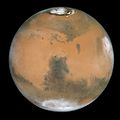Portal:Technology/Selected articles/38
The recorded history of Mars observation dates back to the era of the ancient Egyptian astronomers in the 2nd millennium BCE. Detailed observations of the position of Mars were made by Babylonian astronomers, and ancient Greek philosophers and Hellenistic astronomers developed a geocentric model to explain the planet's motions. Indian and Muslim astronomers estimated its size and distance from Earth. The first telescopic observation of Mars was by Galileo Galilei in 1610. The first crude map of Mars was published in 1840. When astronomers mistakenly thought they had detected the spectroscopic signature of water in the Martian atmosphere, the idea of life on Mars became popular. During the 1920s, the range of Martian surface temperature was measured; it ranged from −85 °C (−121 °F) to 7 °C (45 °F). The planetary atmosphere was found to be arid with only trace amounts of oxygen and water. Since the 1960s, multiple robotic spacecraft have been sent to explore Mars. The planet has remained under observation by ground and space-based instruments and the discovery of meteorites on Earth that originated on Mars has allowed laboratory examination of the chemical conditions on the planet.

